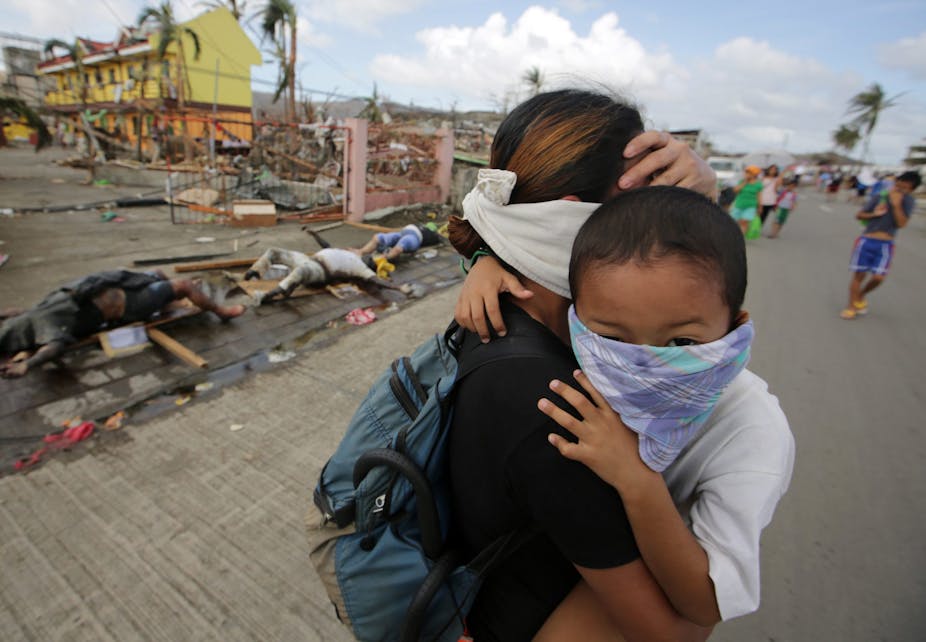Once again, a cataclysmic disaster has hit an Asian nation. But a well co-ordinated aid response mindful of lessons from other disasters could mean a faster recovery.
Last Friday, Typhoon Haiyan (known locally as Yolanda) brought unprecedented winds of up to 275 kilometres an hour ashore in central Philippines. The typhoon destroyed everything in its path, affecting more than nine million people.
According to the United Nations Office for the Coordination of Humanitarian Affairs (OCHA), approximately 660,000 people are currently displaced with around 60% of these inside 1,316 evacuation centres.
Officials in the Leyte province have reported that as many as 10,000 people may have died in Tacloban City alone, and the number of casualties is expected to increase.
The danger from infectious diseases
Asia is disproportionately affected by the wrath of nature. Of the 1.3 million people killed by natural disasters across the world during the first decade of this century, more than 860,000 were Asians.
But will this disaster be followed by another catastrophe, in the form of epidemics of infectious diseases? Experience from similar disasters suggests not.
Disaster-related deaths and injuries are overwhelmingly caused by the initial traumatic impact of the event. The risk of outbreaks is often presumed to be high in the chaos that follows natural disasters.
This fear is probably the result of a perceived link between unburied dead bodies and widespread disease. But there’s no evidence that dead bodies pose a risk for epidemics after natural disasters.
Nonetheless, the risk for outbreaks after disasters is frequently exaggerated by both health officials and the media. The World Health Organization (WHO) has even published a useful list of myths and realities about disaster situations.
A look backward
It’s worth reviewing the aftermath of some of the major natural disasters during the past decade to illustrate the absence of the link between dead bodies and infectious disease epidemics.
When a tsunami struck the Indonesian province of Aceh in 2004, 220,000 people died and more than 500,000 were displaced.
But there were no significant outbreaks of communicable diseases in the months that followed, except for a cluster of 106 cases of tetanus. Tetanus is caused by contamination of open wounds by soil or manure.
Indeed, in the first 12 weeks after the tsunami, only 11 deaths from communicable diseases were reported in Aceh.
A widely publicised epidemic of cholera in Haiti occurred ten months after the catastrophic January 2010 earthquake that displaced over one million people.
Eventually, 680,000 cases of cholera and more than 8,000 deaths were reported. In fact, the cholera outbreak spread rapidly due to the slow restoration of clean water and sanitation facilities after the earthquake.
Outbreaks of cholera also occurred after floods in West Bengal in 1998 and Bangladesh in 2004.
Given there have been sporadic outbreaks of cholera in the Philippines over the past several years, surveillance for the disease is already a high priority in the typhoon-affected areas.

Relief response
Whether the spread of infectious diseases increases in the affected areas of the Philippines will depend on how promptly displaced persons are safely placed in shelters that provide adequate food, clean water, and sanitation.
The immediate priorities for relief response are search and rescue of survivors, triage and treatment of the injured, provision of shelter and other basic needs to the homeless, and a thorough needs assessment.
Key prevention services such as child immunisation must be quickly re-established to prevent outbreaks of diseases, such as measles.
Another priority should be to prevent diseases spread by mosquitoes, which include malaria, dengue fever, and chikungunya.
The establishment of a public health surveillance system that will promptly detect outbreaks of infectious diseases is critical.
We already have well-tested tools that can be adapted to the situation in the Philippines. And surveillance specialists can be quickly mobilised by the Global Outbreak Alert and Response Network.
Learning from the past
It’s important that we heed the lessons of past disaster relief experiences.
Relief efforts can be severely hampered by unsolicited donations of inappropriate items, for instance, and the uninvited arrival of overseas volunteers who don’t have relevant disaster relief skills.
Coordination is paramount.
The United Nations has developed a system of sectoral clusters including logistics, shelter, and health and nutrition, among others. Nominated cluster leaders bring relief agencies together to plan and deliver services in a coherent manner.
A review of the response to the 2004 Indian Ocean tsunami by the Tsunami Evaluation Coalition (TEC) found the fragmented approach to relief assistance partly was due to the proliferation of international agencies and their insistence on distinct programs.
This limited the effectiveness of international assessments and of recovery activities, as did an evident shortage of relevant expertise, high turnover of international staff, and a general lack of appropriate language skills.
One of its most important findings was that disaster response was mostly conducted by the affected people themselves. Practically all immediate life-saving actions and emergency support in the first few days was provided by local people, often assisted by the wider national public and institutions, including the military.
How well the world helps the Philippines recover from Typhoon Haiyan will depend on how much we have learnt from the past. Most importantly, we must let the local people lead the recovery and prevent a stampede of well-meaning but ineffective aid efforts.

